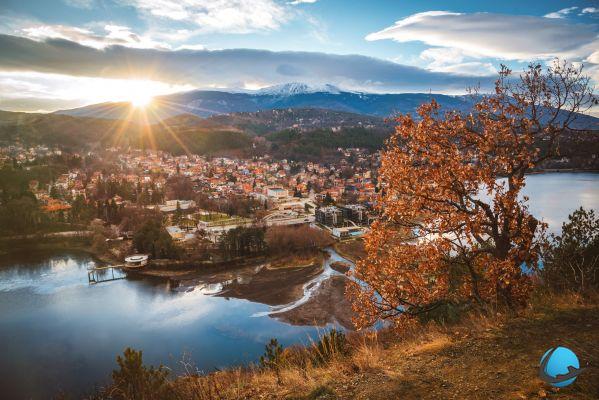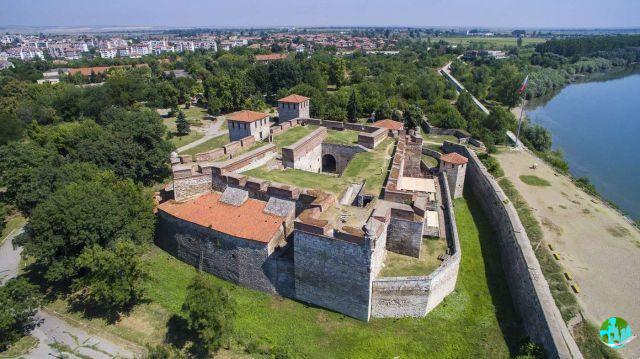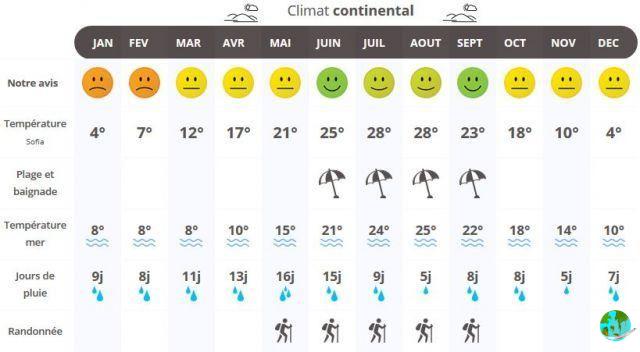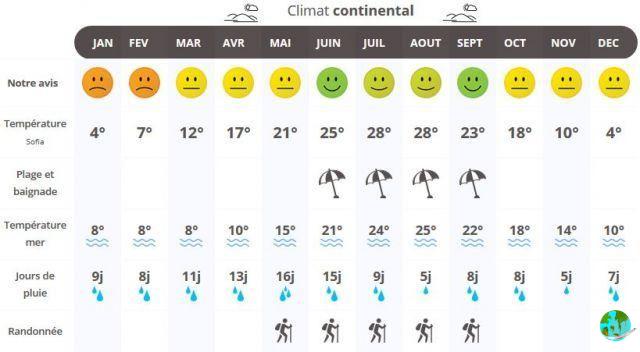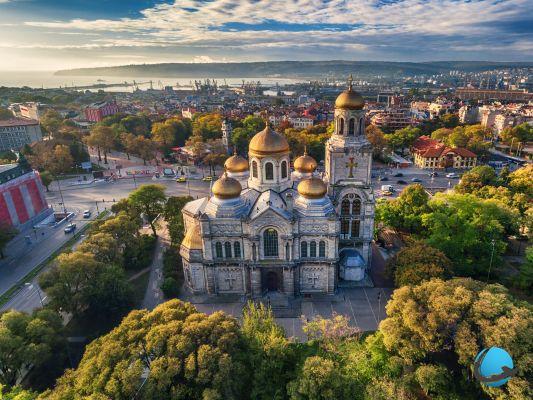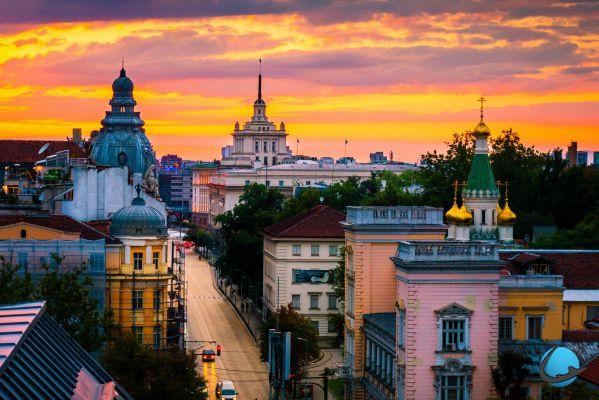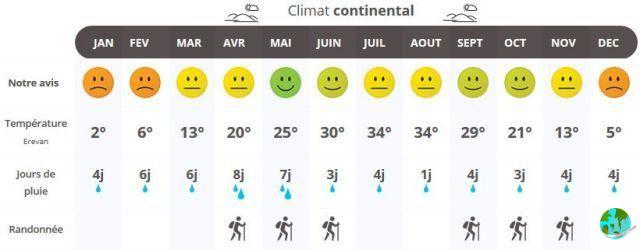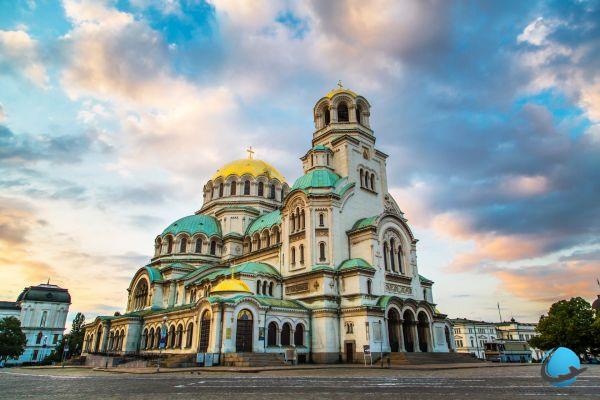
Located at the crossroads of Europe and Asia as well as in northern Greece, Bulgaria is an essentially mountainous country which developed thanks to the Thracian, Slavic, Roman, Byzantine and Ottoman peoples. Many buildings are thus registered with UNESCO, which proves the wealth of this country nestled in the hollow of the Black Sea. Follow the guide to visit Bulgaria with confidence!
What to know before visiting Bulgaria
Bulgaria is a country in south-eastern Europe, in the Balkan region. Member of the European Union since 2007, the country is still relatively unknown at the tourist level. Yet it offers unscathed natural landscapes, sunny beaches along the Black Sea and a grandiose historical heritage (monasteries, ancient cities, tombs, etc.). Populated by 7,2 million inhabitants including 1,2 million residing in Sofia, the capital of the country, Bulgaria shares its borders with Greece, Turkey, Romania, Serbia and North Macedonia.
Bulgarian is spoken there and its alphabet is Cyrillic: sometimes the change of scenery is closer than you think! At the crossroads between Western Europe, the Middle East and the Mediterranean, Bulgaria has the East for its origin and the West for its project. Discover this country where tourist circuits are starting to be organized for take full advantage of the many treasures it has to offer.
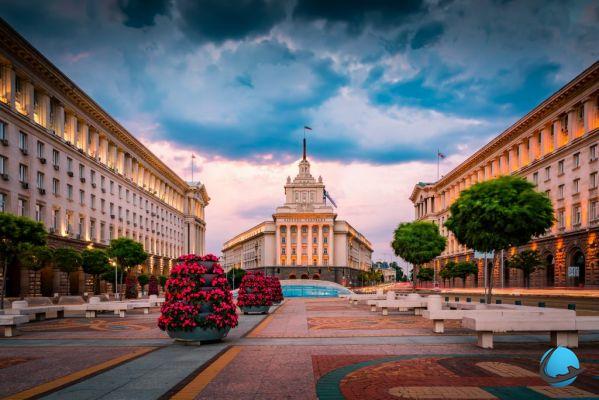 Sofia city
Sofia city
When to go to Bulgaria?
Tourist attendance is at its peak in July, August and September. It is also high in June and lower in January, February, March, April, May, October, November and December. The climate, continental and Mediterranean, is particularly favorable from May to September, during the hottest and most sunny months. For hotels, the rates do not have extravagant differences between the seasons except on the Black Sea coast where accommodation can quickly saturate and prices triple in July and August..
In May, hotels are a little cheaper. February is the month with the least crowds and in January air flights are the cheapest. Bulgaria has the advantage of having the sea and the mountains. Have you ever thought about going skiing elsewhere than in France? The low prices might make you think twice! The first snowfalls arrive around mid-December and you can ski until March or April depending on the year. Winter sports enthusiasts will therefore be delighted to visit Bulgaria during this season, and holidaymakers seeking the sun should prefer spring, a season when the weather is good and there are fewer tourists.
CLIMATE : Monitor the weather forecast month by month to know when to go to Bulgaria.
What budget is to be expected on site?
Bulgaria is renowned for being an inexpensive travel destination. Note that the Bulgarian currency is the Lev, monetary unit since 1881. The average budget per day and per person is 50 €. It can vary between 23 € and 100 € depending on the way you travel: more backpacker, tourist with moderate outings or comfortable tourist. Depending on whether you choose to stay with locals, in a youth hostel or in a hotel, the prices vary between 10 € per person (in a youth hostel or a campsite) and 50 € for two people (in a double room). hotel for example).
In the restaurant, you will eat for a cost between 5 and 10 € : € 5 for an inexpensive meal, between € 5 and € 10 for an average meal with drinks included and around € 10 for a more elaborate meal with tasting of local wine. To visit Bulgaria by public transport, a metro or bus ticket will cost you € 0,77 on average, depending on the time of year.
How to go to Bulgaria?
To get to Bulgaria from France, several possibilities are available to you. The way the fastest and most convenient is the plane. Allow around 3 hours from Paris to Sofia on a direct flight, for an average round-trip cost of € 170. Several planes take off every day from Paris. You can also take off from Marseille, Lyon, Nantes, Bordeaux, Nice, Beauvais or Toulouse, but flights are generally more expensive and longer.
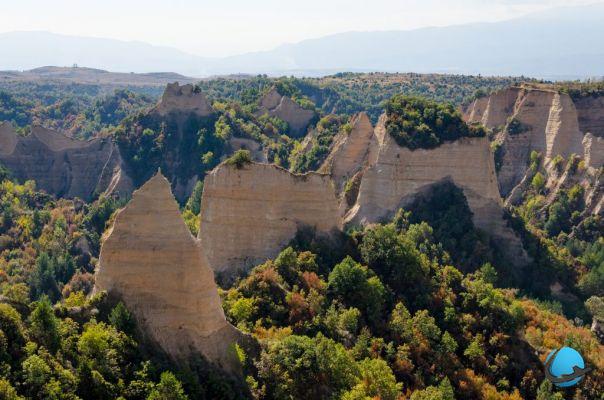 The sandstone pyramids at Melnik
The sandstone pyramids at Melnik
By bus or train, you will need to count around 40 hours of journey. It can be the opportunity to do it in several stages and thus live a great adventure spending time in European cities on your way. Finally, the more adventurous can choose to get there by car. Allow between 16 and 30 hours of travel depending on the starting point and the roads taken. You can choose which European countries to cross: Germany, Switzerland, Croatia, Italy, Austria, Hungary, Slovenia or even Serbia. It is even possible to descend Italy and take the ferry to Greece and then go back up to visit Bulgaria. Wouldn't it be a great opportunity to take the roadtrip you've been dreaming of for a long time?
How to get around the country?
4 main ways of getting around are possible to visit Bulgaria: bus, train, taxis, car. The bravest can choose to explore the country on foot or by bicycle of course, especially since it offers an ideal environment with its natural beauty still intact. If you choose the car, be it your own or a rental car, consider buying a sticker giving the right to travel on the motorway. It can be bought at gas stations. The price is really ridiculous in the countries of Eastern Europe. Count around 8 € for a week of traffic.
For public transport, be careful, everything is written in Cyrillic and English is not very common. The train is widespread in the country, but the network is in need of modernization. The fare is very low, cheaper than the bus. Please note that the stops are not announced. In city centers, taxis are plentiful and very inexpensive : 0,70-1 Lev of support added to 0,70 to -1 Lev per kilometer depending on the location, the taxi and the time of day.
What are the culinary specialties of Bulgaria?
We already know it from France: Bulgarian yogurt is a Bulgarian specialty. But the country is full of other dishes to discover during your stay. Start with a shopska salata, la salade nationale composed of cucumbers, tomatoes, onions and grated sirene - a salty white cheese made from sheep's or cow's milk. You can accompany it with the rakia, a brandy between 40 and 80%, yes, it is drunk at the entrance! It is often made from plum, grape, apple or cherry juice. It is a real institution. If it's too strong, you can also drink mastica, an anise-flavored alcohol; rose, raspberry or morello cherry liqueurs; Cognacs; or ayran, a non-alcoholic drink that is a mixture of yogurt and water.
 Traditional Bulgarian salad
Traditional Bulgarian salad
Enjoy soups, such as bob chorba a bean soup; chkembe tchorba, tripe pudding soup, with peppers, garlic and vinegar or tarator, a cold soup made with yogurt, cucumber and dill. The different flavors are typical of the Balkan region, you will find great similarities with surrounding countries such as Greece or Turkey.
Where in the country to stay?
To find accommodation and visit Bulgaria, we advise you to look at fairly developed and touristic cities. The country is starting to offer good conditions for a vacation, it is not yet saturated with mass tourism. Inland, therefore prefer the capital, Sofia, and Povdiv, the second largest city in the country., elected European Capital of Culture in 2019; along the Black Sea coast, choose Varna, Bourgas, Nessebar or Sozopol for example where the hosting solutions are more varied.
Wild camping is officially banned and camping solutions are currently quite rudimentary. Youth hostels are plentiful in the aforementioned cities. Homestays are widespread and are very good value for money. There are a multitude of small hotels, really cheap, but you should not always expect the same requirements as hotels in Western Europe. Finally, if you want to think outside the box, you could turn to the Bulgarian Association for Alternative Tourism which lists family dwellings certified "Green lodge" for their ecological sensitivity.
Where to go and what to see in Bulgaria?
Here are the 4 hidden treasures you absolutely must visit during your trip to Bulgaria:
Sofia the Holy
Sofia, the Bulgarian capital, takes its name from the Byzantine Church of Hagia Sophia, the oldest church in Sofia. For some time it became a mosque, it has regained its original functions while becoming a tourist center of prime importance. The city obviously has national museums, such as that of culture or that focused on archeology, not to mention the splendid Saint-Alexandre-Nevski Cathedral. This city on a human scale has a very pleasant center, in which it is good to stroll.
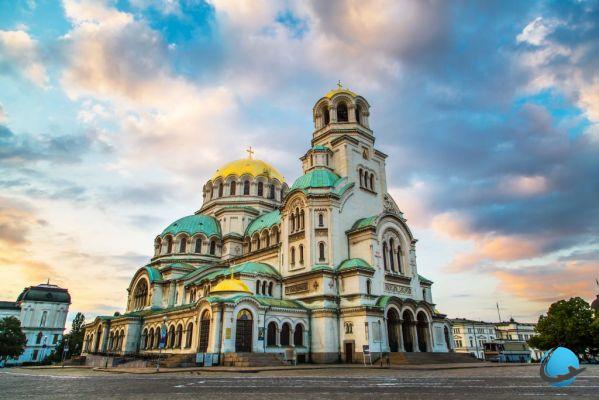 Saint Alexander Nevsky Cathedral in Sofia
Saint Alexander Nevsky Cathedral in Sofia
Old plovdiv
Plovdiv is as old as Troy, and therefore older than Rome or Athens. However, its most brilliant time is under the Roman Empire: this city then became the capital of the Thracian region. This rich past unfolds before the eyes of tourists with the Roman amphitheater and stadium. However, the second Bulgarian city did not stand still: it knew how to evolve. This is evidenced, for example, by the Balabanova House, whose interior is devoted to the daily life of the inhabitants of Plovdiv in the 19th century.
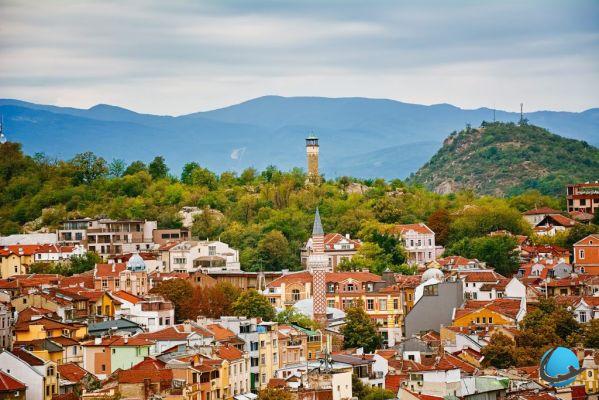 View over Plovdiv
View over Plovdiv
The Black Sea: rediscovering seaside tourism
Bulgaria is bordered by the Black Sea for 378 km. This coast allows the country to diversify its tourism. Thereby, some water sources reaching temperatures close to 50 ° C allow the Varna region to specialize in seaside tourism. The Black Sea, which is only black in name, allows tourists to enjoy beautiful beaches with golden sand. The most visited cities are undoubtedly Varna and Burgas. These two cities have in common the maritime garden that they offer: a garden proposed by the sea. That of Varna houses an aquarium and an air naval museum.
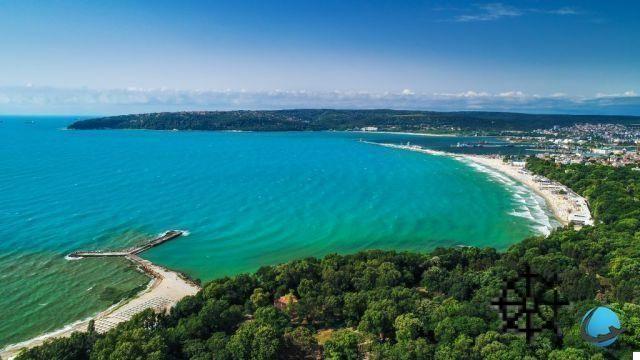 Aerial view of Varna
Aerial view of Varna
Rila Monastery: UNESCO World Heritage
Bulgarian Renaissance style (it was rebuilt in the 19th century), the Rila monastery is a UNESCO World Heritage Site. It rises on several floors that encircle a square courtyard, in which the conventual church and the Khrelio tower are erected. The monks' cells welcome tourists at night. Some may wish to stay to see the collections of medieval manuscripts, the woodcarvings or the iconostasis of the church. Others will rest at the hotel after hiking in Rila National Park and its colorful lakes and glacial cirques.
SEE ALSO : The 10 most beautiful Bulgarian monasteries to visit
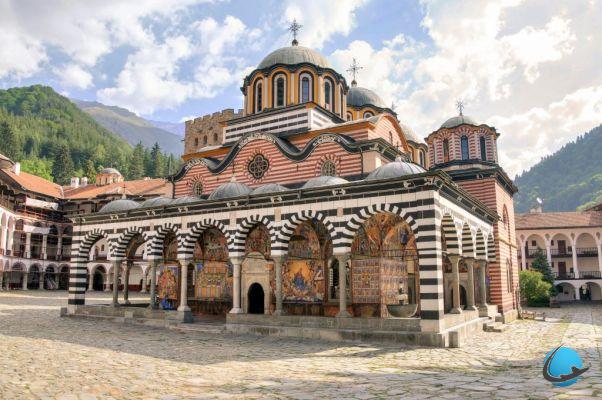 Rila Monastery
Rila Monastery
Useful information
To prepare your trip to Bulgaria in the best possible way, check out all our practical information:
- Formalities: For a stay of less than 3 months, a simple valid identity card is sufficient. Prepare your passport if you are passing through Serbia.
- Health : No special precautions to be taken. Be up to date with your vaccinations and if you are going to the center of the country or to remote areas, you can schedule the vaccine against rabies and Central European Tick Encephalitis.
- Cash : Bulgaria is not yet in the euro zone. The Bulgarian currency is the Bulgarian Lev.
- Visitor Center : Prepare your trip by contacting the Bulgarian tourist office. A lot of information will be provided to you!
On the way to discover the secrets of Bulgaria!
Do you plan to go to this eastern country? Tell us about your preparations in the comments!




